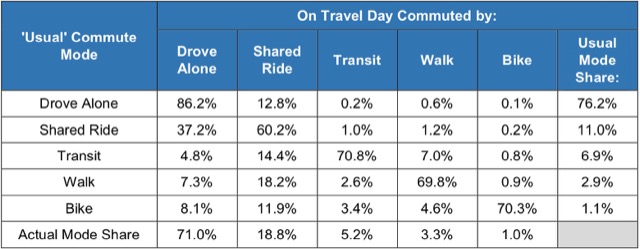
According to the 2017 American Community Survey, about 7.6 million Americans, or 5.3 percent of commuters, take transit to work. However, the actual question on the survey asks, how do you “usually get to work last week.” If someone took transit three days and drove two, then transit gets checked. So how many really use transit on any given day?

Fortunately, table 26 in the 2017 Summary of Travel Trends from the National Household Travel Survey helps answer this question. This survey asked both how people usually got to work and how they actually got to work on a particular day. The above table is a crosswalk showing that people who say they usually drove to work actually drove about 98 percent of the time, but people who say the usually take transit actually took transit only about 71 percent of the time. Carpooling was the big winner because people who say they usually took another mode most often carpooled when they didn’t use that other mode.
After accounting for how often people who usually used other modes sometimes took transit, the share of people who actually take transit on any given day is only about 76 percent of those who say they usually take transit. However, while 5.3 percent of commuters told the American Community Survey they usually take transit, 6.9 percent of commuters told the National Household Travel Survey they usually take transit, and 75 percent of that is 5.2 percent, almost exactly the same as the American Community Survey.
So, which is it: 5.2 percent or 76 percent of 5.3 percent (which is just under 4.0 percent)? I’m inclined to say closer to the latter number. The National Household Travel Survey results were based on answers from 26,000 households. The American Community Survey was based on answer from 3.5 million households, so it is likely to have a much smaller sampling error. (The National Household Travel Survey also surveyed another 100,000 households, but only in eleven states that paid for the privilege of having more detailed answers, and they weren’t likely a representative sample of the nation as a whole.)
So it seems likely that, on average, fewer than 6 million commuters, out of about 145 million, ride transit on any given day. While I wouldn’t say this reduction is reliable in any particular city (it is probably more reliable in, say, San Jose than in New York City), it is useful to keep in mind that transit commuting numbers in the American Community Survey are probably overestimated.
This piece first appeared on The Antiplanner.
Randal O’Toole (rot@ti.org) is a senior fellow with the Cato Institute and author of the new book, Romance of the Rails: Why the Passenger Trains We Love Are Not the Transportation We Need, which will be released by the Cato Institute on October 10.
Photo: Gillfoto from Juneau, Alaska, United States (CBJ Transit Center) [CC BY-SA 2.0 ], via Wikimedia Commons












